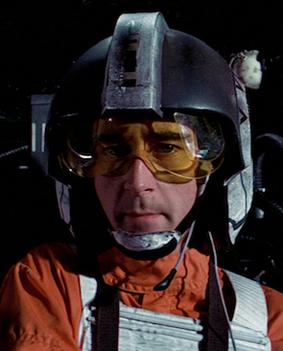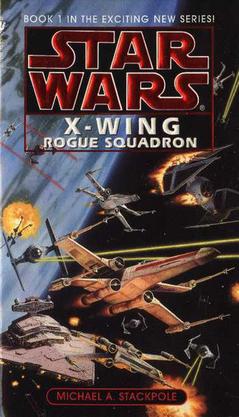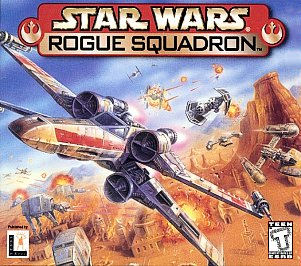
Star Wars is an American epic space opera media franchise created by George Lucas, which began with the eponymous 1977 film and quickly became a worldwide pop culture phenomenon. The franchise has been expanded into various films and other media, including television series, video games, novels, comic books, theme park attractions, and themed areas, comprising an all-encompassing fictional universe. Star Wars is one of the highest-grossing media franchises of all time.

Wedge Antilles is a fictional character in the Star Wars franchise. He is a supporting character portrayed by Denis Lawson in the original Star Wars trilogy, and voiced by David Ankrum in Episode IV – A New Hope (1977) and Rogue One (2016). He is also featured in the Star Wars expanded universe, most notably as the lead character in most of the X-Wing novels. Antilles has also appeared in the sequel trilogy film The Rise of Skywalker (2019), with Lawson reprising his role; in the 2014 animated series Star Wars Rebels, voiced by Nathan Kress; and in the 2023 second volume of Star Wars: Visions, voiced again by Lawson.

The X-wing starfighter is a name applied to a family of fictional spacecraft manufactured by the Incom Corporation and later the Incom-FreiTek Corporation from the Star Wars franchise. Named for the distinctive shape made when its s-foils (wings) are in attack position, the X-wing was a class of starfighter used by the Rebel Alliance in their conflict with the Galactic Empire. It made its theatrical debut, as the T-65B model, in Star Wars (1977) as the spacecraft piloted by Luke Skywalker and the Red Squadron when Luke destroyed the Death Star. The starfighter featured extensively in the Star Wars original trilogy and in the Expanded Universe that followed, and has been merchandised as a variety of toys and models.

The GameCube is a home video game console developed and marketed by Nintendo. It was released in Japan on 14 September 2001, in North America on 18 November 2001, in Europe on 3 May 2002, and in Australia on 17 May 2002. It is the successor to the Nintendo 64 (N64) and the predecessor to the Wii. As a sixth-generation console, the GameCube primarily competed with the PlayStation 2 and Xbox.

Nintendo Selects is a marketing label previously used by Nintendo to promote best-selling video games on Nintendo game consoles. Nintendo Selects titles were sold at a lower price point than new releases. The program paralleled other budget range software by Sega, Sony, and Microsoft to promote best-selling games on their consoles as well. In Japan, the discount label was introduced in 2015 for various Nintendo 3DS titles as the Happy Price Selection, although South Korea adopted the Nintendo Selects name at an earlier period. The most recent Nintendo Selects titles were released for the Wii U and 3DS and, as of January 2024, no Nintendo Switch games have been rebranded as Nintendo Selects.

Factor 5 GmbH is an independent software and video game developer. The company was co-founded by five former Rainbow Arts employees in 1987 in Cologne, Germany, which served as the inspiration behind the studio's name.
Star Wars: Rogue Squadron is a series of Star Wars action video games jointly developed by LucasArts and Factor 5 and published by LucasArts for Nintendo consoles. Aspyr has expressed interest in bringing the series to the Nintendo Switch.

Star Wars Rogue Squadron II: Rogue Leader is an action game co-developed by Factor 5 and LucasArts and is the second of the Rogue Squadron series. It was published by LucasArts and released as a launch title for the GameCube in North America on November 18, 2001, and Europe on May 3, 2002. Set in the fictional Star Wars galaxy, the game spans all three original trilogy Star Wars films. The player controls either Luke Skywalker or Wedge Antilles. As the game progresses, Skywalker, Antilles and the Rebel Alliance fight the Galactic Empire in ten missions across various planets.
Goldeneye or GoldenEye may refer to:

Over one hundred video games based on the Star Wars franchise have been released, dating back to some of the earliest home consoles. Some are based directly on films while others rely heavily on the Star Wars Expanded Universe.

Star Wars Episode I: Battle for Naboo is an arcade-style action game co-developed by Factor 5 and LucasArts. It is a spiritual successor to Star Wars: Rogue Squadron released two years earlier. Despite the similarities between the two games, the development team designed a new game engine for Battle for Naboo and included land- and water-based combat in addition to aerial combat. The player can control various air, land, and water vehicles; each offers a unique armament arrangement, as well as varying degrees of speed and maneuverability. Bonus power-ups that improve these crafts' weapons or durability are hidden in different levels throughout the game. The player's performance is checked against four medal benchmarks after the completion of each level. Acquiring these medals promotes the player's rank and helps unlock hidden content.

Star Wars: X-wing is a ten-book series of Star Wars novels by Michael A. Stackpole and Aaron Allston. Stackpole's contributions cover the adventures of a new Rogue Squadron formed by Wedge Antilles, while Allston's focus on Antilles' Wraith Squadron.
The Nintendo Player’s Guides are a series of video game strategy guides from Nintendo based on Nintendo Power magazine.

Star Wars Rogue Squadron III: Rebel Strike is an action video game developed by Factor 5 and published by LucasArts for the GameCube. The game is set during the original Star Wars trilogy and recreates battles that take place during those films. The game follows Rogue Squadron, which, under the command of Luke Skywalker and Wedge Antilles, uses starfighters to engage and defeat the Galactic Empire.

Star Wars: Rogue Squadron is an arcade-style flight action game co-developed by Factor 5 and LucasArts. The first of three games in the Rogue Squadron series, it was published by LucasArts and Nintendo and released for Microsoft Windows and Nintendo 64 in December 1998. The game's story was influenced by the Star Wars: X-wing – Rogue Squadron comics and is set in the fictional Star Wars galaxy, taking place primarily between events in the films Star Wars and The Empire Strikes Back. The player controls Luke Skywalker, commander of the elite X-wing pilots known as Rogue Squadron. As the game progresses, Skywalker and Rogue Squadron fight the Galactic Empire in 16 missions across various planets.
The X-wing fighter is a starfighter from the fictional Star Wars universe.
Star Wars: Battlefront is a series of first- and third-person shooter video games based on the Star Wars franchise. Players take the role of characters from the franchise in either of two opposing factions in different time periods of the Star Wars universe. The series was launched in 2004 by LucasArts with Star Wars: Battlefront, developed by Pandemic Studios for LucasArts. The game received positive reviews and sold well. In 2005 Pandemic developed a sequel, Star Wars: Battlefront II, which was also critically and commercially successful.
Rogue Leader may refer to:
The Nintendo Gateway System is a version of the Super Nintendo Entertainment System, Game Boy, Game Boy Color, Game Boy Advance, Nintendo 64, or GameCube that was installed on some Northwest, Singapore Airlines, Air China, Air Canada, Alitalia-Linee Aeree Italiane, All Nippon Airways, British Midland International, Kuwait Airways, Malaysia Airlines, Thai Airways, and Virgin Atlantic passenger aircraft, as well as certain hotels with LodgeNet, NXTV, or Quadriga, from late 1993 up until the late 2000s.










